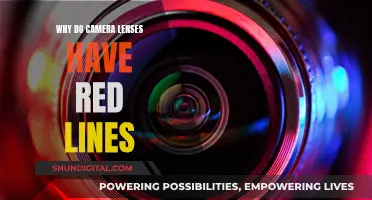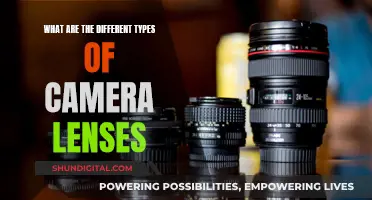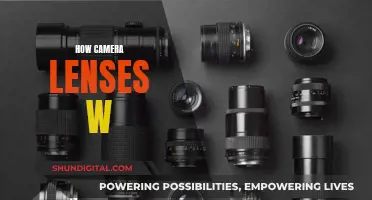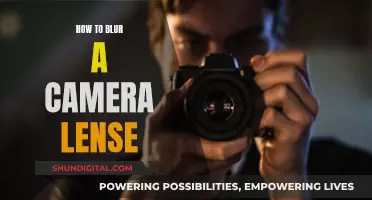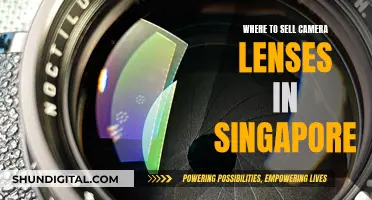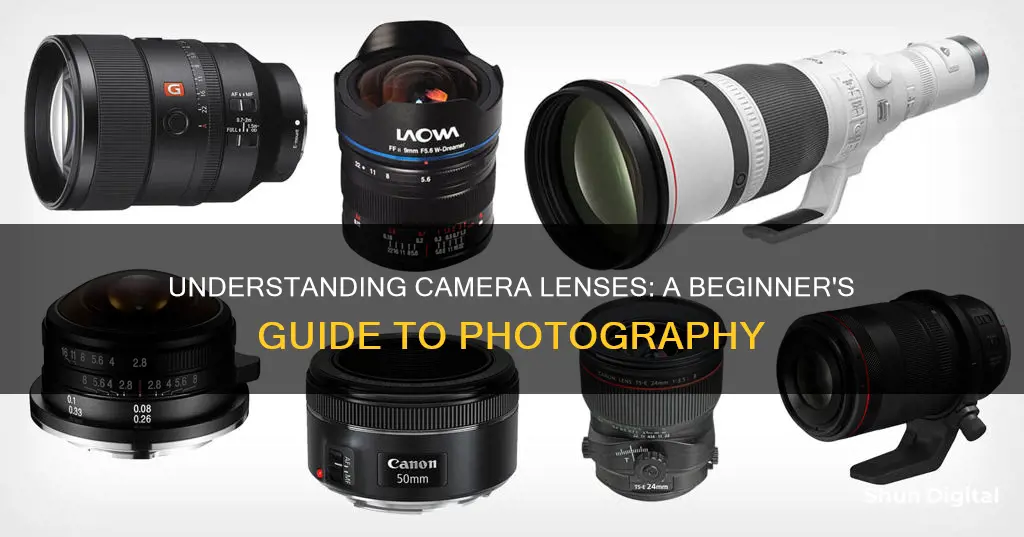
Camera lenses are arguably the most important piece of equipment a photographer can buy, even more so than the camera itself. Lenses work similarly to the human eye, allowing light to enter the camera and helping to focus it.
The lens is made up of several lens elements, each of which directs light rays to create an image on the digital sensor. The goal is to minimise aberrations, while using the fewest and least expensive elements.
There are two main types of lenses: prime and zoom. Prime lenses have a fixed focal length, while zoom lenses have variable focal lengths. Zoom lenses are generally more versatile, but prime lenses often produce sharper, higher-quality images.
When choosing a lens, there are several factors to consider, including purpose, speed, format, features, focal length, aperture, and cost.
What You'll Learn

Focal length
The focal length of a lens determines its angle of view, and thus how much of a scene will be captured, and how much the subject will be magnified. The longer the focal length, the narrower the angle of view and the higher the magnification. Conversely, a shorter focal length results in a wider angle of view and lower magnification. This means that a lens with a short focal length captures a much broader view than a lens with a longer focal length.
There are two types of lenses: prime and zoom. Prime lenses have a fixed focal length, while zoom lenses have variable focal lengths. Zoom lenses are more versatile and convenient as you can carry just one lens to be prepared for a range of shooting situations. On the other hand, prime lenses tend to be more compact and lightweight than zoom lenses, and they also tend to have a larger maximum aperture, which is useful in low-light conditions.
Preventing Camera Lens Fog: Tips for Clear Shots
You may want to see also

Aperture
The aperture setting is identified by an f-number, also known as the f-stop. This is a ratio comparing the focal length to the effective aperture diameter. A wide aperture has a lower f-stop, allowing more light to enter, while a small aperture has a higher f-stop, letting less light in.
On the other hand, a small aperture will give you a wider depth of field, making both the foreground and background sharp. Landscape photographers often use this effect. A higher aperture (e.g. f/16) is better when you want everything in your shot to be in focus.
It's important to note that small f-numbers represent large apertures, and large f-numbers represent small apertures. So, f/2.8 is a larger aperture than f/16. This can be confusing, but think of it as a fraction: f/16 is like 1/16th, which is clearly smaller than 1/4th or f/4.
When choosing the right aperture, consider the context of what you're shooting. If you want a dynamic shot with a blurred background, go for a lower aperture. If you need everything in focus, opt for a higher aperture. Play around with different apertures to find the "sweet spot" that suits your style.
Samy's Camera: Renting Lenses and Photography Equipment
You may want to see also

Prime lenses
The three most popular and widely used standard prime lenses are the 35mm, 50mm, and 85mm lenses. They are available in a range of aperture speeds and are ideal for shooting street photography and interiors due to their minimal distortion and wide angle of view.
Camera Lenses: Reselling and Buying Used
You may want to see also

Zoom lenses
The advantage of a zoom lens is its versatility. They are ideal when photographing a variety of subjects, such as landscapes and portraits, and when you want to use just one lens for all situations. Using a zoom lens also reduces the number of times you need to change the lens, saving time and limiting the possibility of dust getting into the camera. Zoom lenses are often described by the ratio of their longest to shortest focal lengths. For example, a zoom lens with focal lengths ranging from 100mm to 400mm may be described as a 4:1 or "4x" zoom.
One of the trade-offs of the convenience of variable focal length offered by zoom lenses is some compromise on image quality. All zoom lenses suffer from at least a slight loss of image resolution at their maximum aperture, especially at the extremes of their focal length range. This effect is more noticeable in the corners of the image when displayed in a large format or high resolution. The greater the range of focal lengths offered by a zoom lens, the more exaggerated these compromises become.
Camera Lenses: Tax Benefits and What Qualifies as 'Listed Property
You may want to see also

Macro lenses
"True" macro lenses are able to project subjects onto the camera's sensor at life-size, resulting in a 1.0x Maximum Magnification at the lens' Minimum Focus Distance. A select few macro lenses exceed life-sized reproduction for the ultimate in close-up DSLR photography.
When choosing a macro lens, it's important to consider the magnification ratio, as this will determine how close you can get to the subject. A 1:1 macro lens can reproduce objects at life-size, while a 1:2 macro lens can reproduce objects at half their size.
In addition to their close-focusing capabilities, many macro lenses are designed with a flat focus field, allowing the image to be in focus from edge to edge in the frame.
The Ultimate Camera Lenses for Professional Photography
You may want to see also
Frequently asked questions
Camera lenses are essential as they control which photos you can take by allowing you to control the amount of light that enters your camera. The lens is what focuses light from what you see through the viewfinder into a tiny spot on the back of your camera. If you remove the lens from your camera, the only kind of image you can produce is white light.
Focal length, usually represented in millimeters (mm), is the basic description of a photographic lens. It is a calculation of an optical distance from the point where light rays converge to form a sharp image of an object to the digital sensor in the camera. The longer the focal length, the higher the magnification and the narrower the angle of view. The shorter the focal length, the wider the angle of view and the lower the magnification.
The aperture of your lens is the opening that allows light to enter and reach your camera’s sensor. It is measured in F-numbers or F-stops. A smaller F-number, such as f/1.8, will give you a sharp focal point with a soft blurry background. A larger F-number, like f/16, will give you a larger depth of field, resulting in both the foreground and background being in focus.


